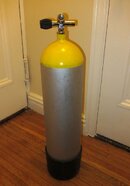OK, I really can't find the answer to this online, and the dive shops that I called don't do this work either.
I have these Asahi tanks, steel 120s, that I got used last year. I do like the weight characteristics, but I don't think that I was that good about maintenance. I probably let them dry without a good rinse, and without taking off the boot and removing retained water, etc... This picture is from before last season, before they started to rust on the sides.

They are painted, not galvanized. I think at some point I will replace them with galvanized 100s that I might double up, but that is not for a while.
Right now there is a good bit of rust on them, mostly on the bottom, but a bit on the sides. I was planning on trying to fix this myself, and need some advice.
I was going to take a steel brush drill attachment and/or steel wool and get rid of the rust. Do I need to completely remove all of the old paint? Do I need primer? Marine paint? Or just take off some of the rust and try to be better about rinsing and drying them after diving...
OR, are there companies that do this sort of job the right way? I'm in the NYC area...
Any suggestions would be most appreciated!
Thanks,
Mike
I have these Asahi tanks, steel 120s, that I got used last year. I do like the weight characteristics, but I don't think that I was that good about maintenance. I probably let them dry without a good rinse, and without taking off the boot and removing retained water, etc... This picture is from before last season, before they started to rust on the sides.
They are painted, not galvanized. I think at some point I will replace them with galvanized 100s that I might double up, but that is not for a while.
Right now there is a good bit of rust on them, mostly on the bottom, but a bit on the sides. I was planning on trying to fix this myself, and need some advice.
I was going to take a steel brush drill attachment and/or steel wool and get rid of the rust. Do I need to completely remove all of the old paint? Do I need primer? Marine paint? Or just take off some of the rust and try to be better about rinsing and drying them after diving...
OR, are there companies that do this sort of job the right way? I'm in the NYC area...
Any suggestions would be most appreciated!
Thanks,
Mike





